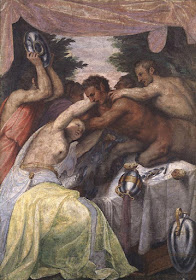 |
| Lattanzio Gambara Wedding of Pirithöus and Hippodamia ca. 1560 fresco transferred to canvas Royal Collection, Great Britain |
 |
| Lattanzio Gambara Wedding of Pirithöus and Hippodamia ca. 1560 fresco transferred to canvas Royal Collection, Great Britain |
 |
| Lattanzio Gambara Wedding of Pirithöus and Hippodamia ca. 1560 fresco transferred to canvas Royal Collection, Great Britain |
 |
| Lattanzio Gambara Ceres ca. 1555-60 fresco Pinacoteca Tosio Martinengo, Brescia |
 |
| Lattanzio Gambara Agrippine Sybil ca. 1555-60 fresco transferred to canvas Glasgow Museums |
"In Brescia the veristic tendency that had so strongly marked its painting in the second quarter of the Cinquecento yielded, after Romanino and Moretto had died, to a more urbane fashion. Lattanzio Gambara, Romanino's collaborator and son-in-law, the chief painter of the later Brescian school, had brought to Romanino when he joined him about 1550 the Emilian inclinations of a painter trained until then in the Cremonese school; his master apparently had been Giulio Campi. During the decade when Gambara worked for the ageing Romanino he acceded only partly to the latter's lead of style, asserting his Mannerist affiliations instead. Indeed, Gambara seems to have helped to incline the older painter towards the Romanism he exhibited in his latest years. Gambara's Maniera in his secular fresco decorations of the later fifties and early sixties is often spirited and occasionally even inventive. But a counter-effect on Gambara of the Brescian environment slowed his Maniera impetus: compromising between Brescian tradition and Maniera, his style turned after a while into a classicist academicism, laboured, turgid, and correct. His last work was not in Brescia but in Parma, where he shared the task of decoration of the nave arcade of the cathedral (at intervals between 1567 and 1573) with the Cremonese Sojaro [Bernardino Gatti]. Desiring not only the correctness of an academic style but its pretence to the grand manner also, he sought accessible examples from which to borrow it in Giulio Romano and Pordenone."
– S.J. Freedberg from Painting in Italy - 1500 to 1600 in the Pelican History of Art series (London, 1971)
 |
| Lattanzio Gambara Christ Ascending to Heaven (study for fresco, Parma Cathedral) ca. 1567-73 drawing British Museum |
 |
| Lattanzio Gambara Three Apostles witnessing the Ascension (study for fresco, Parma Cathedral) ca. 1567-73 drawing British Museum |
 |
| Lattanzio Gambara Five Apostles witnessing the Ascension (study for fresco, Parma Cathedral) ca. 1567-73 drawing British Museum |
 |
| Lattanzio Gambara Standing Warrior (study for fresco, Parma Cathedral) ca. 1571-73 drawing Morgan Library, New York |
 |
| Lattanzio Gambara Two Prophets seated on Clouds (study for fresco, Parma Cathedral) ca. 1567-73 drawing Royal Collection, Great Britain |
 |
| Lattanzio Gambara Figure climbing onto a Cloud (study for fresco, Parma Cathedral) ca. 1567-73 drawing Morgan Library, New York |
 |
| Lattanzio Gambara Study for a Prophet (study for fresco, Parma Cathedral) ca. 1567-73 drawing National Gallery of Art, Washington DC |
 |
| Lattanzio Gambara Massacre of the Innocents (study for fresco, Parma Cathedral) ca. 1567-73 drawing Morgan Library, New York |
 |
| Lattanzio Gambara St Roch interceding with Christ on behalf of Plague Victims (study for fresco, Parma Cathedral) ca. 1567-73 drawing National Gallery of Art, Washington DC |
 |
| Lattanzio Gambara Plague Victims beseeching Christ, the Virgin and St Roch (study for fresco, Parma Cathedral) ca. 1567-73 drawing National Gallery of Art, Washington DC |











































